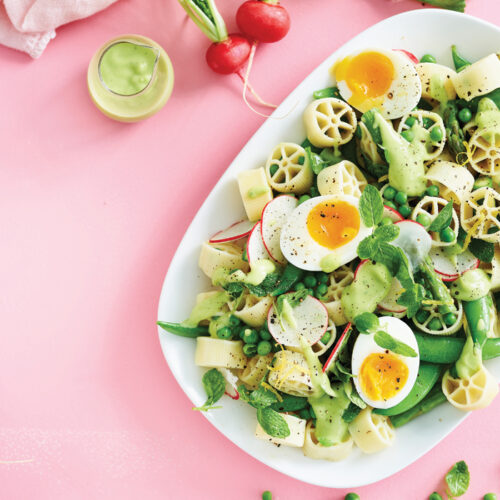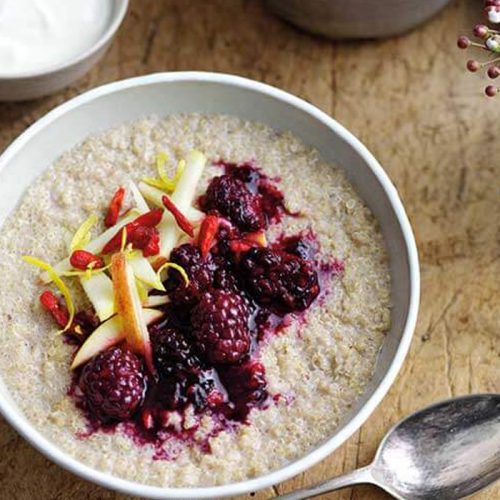
Do your pants fit a bit more snugly around your stomach at the end of the day, but you can’t quite figure out why? HFG uncovers five common culprits of bloating.
Bloating, gassy, puffy or distended — whatever you call it, that annoying feeling in the belly affects around 30 per cent of us.
For some, it’s so severe it can seriously impact day-to-day life, but for most of us, some degree of bloating can be a completely normal part of our lives.
Bloating is the build-up of fluid or gas in your stomach, usually after a meal, which leaves you feeling full and uncomfortable. It’s more common in women than men, and most often experienced in the afternoon or evening. It can often resolve itself within a short period of time, but it can also be frustrating to find no relief when the cause is not entirely clear.
Let’s walk through five common causes of bloating, and some simple lifestyle tweaks to bring relief, naturally.
1. You eat too quickly
What’s happening?
We’re all busy, and sometimes eating on the run is the only choice. But if you’re prone to bloating, it pays to find a little extra time to stop and eat. When you eat quickly you swallow more air than if you eat slowly, and that causes oxygen to become trapped in your gut. On top of that it takes about 20 minutes for your gut to signal your brain that it’s full, so you’re prone to overeating too. Hello bloated belly!
How to find relief
It can be tough to change your usual eating pace, but three practical tips can help you navigate your way out of the fast lane:
- Schedule 20 minutes to sit down and eat each main meal. Use these times for eating only.
- Avoid distractions like text messages, emails and TV during mealtimes. These can take your attention away from eating, making you speed up without realising it and consume your meal without savouring it.
- Pay attention to the look, smell, taste and texture of your food before swallowing each mouthful. Put your cutlery down after each bite and chew well.
2. You’re constipated
What’s happening?
In contrast to soft, bulky stools, constipation results in a hard, dry, pellet-like consistency that is difficult to pass. While there is no set rule for how often you should go to the toilet, going less often than you usually do is an indication you might be constipated. Aside from bloating, constipation can also cause cramping and leave you feeling as though your bowels aren’t completely empty.
How to find relief
Fibre is key for beating constipation. Here’s how you can bump up your intake:
Go for whole grains such as grainy bread, rolled oats and quinoa. They have more fibre than their refined counterparts such as white bread or white rice.
Fill half your plate with vegetables at each main meal. Also, the skin of most vegetables is where most of the fibre is, so be mindful of which ones you choose to peel.
Stock up on nuts and seeds. Sprinkle them over a salad, swirl them through yoghurt or enjoy as a healthy snack.
Eat more legumes such as baked beans or roasted chickpeas. They’re rich in fibre and a good source of protein.
3. You have Irritable Bowel Syndrome (IBS)
What’s happening?
Around 10 to 20 per cent of us experience unpleasant IBS symptoms, where the gut is extremely sensitive to distension. For this reason, the natural expansion of the bowel during digestion can be more painful for someone with IBS, and can lead to uncomfortable gas and bloating, as well as constipation and/or diarrhoea.
How to find relief
Research indicates that a low-FODMAP diet is an effective way of managing IBS, with three in four people finding an improvement in symptoms with the diet. Put simply, FODMAPs are carbohydrates that escape digestion and ferment in the large bowel, producing gas. They’re widespread throughout the food supply in everything from breads and cereals through to dairy and, even, fruit and vege.
The tricky part is that people with IBS are usually only sensitive to some, not all, types of FODMAPs, so it’s a good idea to see an experienced dietitian to help you identify your unique triggers. They’ll guide you through a strict low-FODMAP diet for four to six weeks, then systematically test and challenge each type of FODMAP. The last step is to liberalise your diet to increase variety while minimising symptoms.
When to get help
Tried everything and still find it hard to beat the bloat? Bloating can be a sign of a more serious condition such as inflammatory bowel disease, coeliac disease or even certain types of cancer. If your bloating persists day and night, progressively worsens or is accompanied by symptoms, such as weight loss, nausea, abdominal pain, changes in bowel habits or blood in your stools, it’s important to see your doctor.
Common food culprits for wind and bloating
Some foods are more likely than others to cause wind and bloating. they are:
Chewing gum, which usually contains artificial sweeteners that can cause digestive issues in some people. Chewing gum also makes you swallow more air, which can exacerbate the problem.
Legumes (chickpeas, beans and lentils) have a FODMAP that the digestive tract has trouble absorbing, giving rise to gas and bloating.
Processed meats, store-bought sauces and savoury snacks can all be high in salt, which causes the body to retain fluid, leaving you feeling bloated afterwards.
Milk can cause bloating in those who are intolerant to lactose, the natural sugar in milk. Lactose is also a type of FODMAP, so can be troublesome for those with IBS. Carbonated drinks can lead to a build-up of gas in the stomach and, therefore, bloating. Onion and garlic are common bloating culprits in people with IBS, as they are high in FODMAPs. Try using garlic- or onion-infused olive oil instead to help alleviate symptoms.
4. You eat too much fibre
What’s happening?
Raising your fibre intake too quickly — especially without upping your water intake — can cause bloating too. That’s because fibre draws water into the bowel to soften the stool, so, without enough water, your bowel motions dry up, causing constipation-like symptoms, including bloating.
How to find relief
Increase fibre intake slowly to allow your body to become accustomed to the extra fibre, and up your water consumption at the same time. For example, start by switching from white bread to whole grain, then replace refined breakfast cereal for rolled oats and, later, exchange white rice for brown rice, over a few weeks.
Lift your intake of legumes, vege and fruit in a similar way.
5. You’re sitting too much
What’s happening?
If your diet is full of fibre but you’re still constipated and feeling bloated, the missing link could be regular exercise. Getting moving gets things moving. Sitting at your desk all day can leave you feeling sluggish and bloated, especially after lunch. So, getting up from your seat at least every hour helps your digestive system work more efficiently. Working out stimulates the digestive tract and strengthens core muscles, which is important for a well-functioning gut.
How to find relief
Make exercise part of your daily routine — just like brushing your teeth. Anything that helps get your heart rate up is good. at a minimum, just 20 minutes a day helps. Try a brisk walk around the park at lunchtime, or a fun dancing class on the weekend. Just stick to it, and your gut will thank you for it.
6 foods or drinks that boost digestive health
Psyllium husk
Why it’s good
Psyllium husk is high in fibre and helps keep food moving through your system. You can find the husk in the health food aisle.
How to use it
Sprinkle psyllium husk on cereal or salads, or add it to muffin, cake or loaf recipes.
Metamucil/Benefibre
Why it’s good
Both of these fibre supplements help relieve constipation.
How to use them
Try the capsules, or mix the powder (clear, flavoured or sugar-free varieties are available) with water and drink 1–3 times each day.
Kefir
Why it’s good
Fermented, probiotic drinks add good bacteria to your digestive tract and help to maintain the bacterial balance in your gut.
How to use it
Drink it once a day or add it to smoothies or the milk you pour on your cereal.
Peppermint tea
Why it’s good
Sipping peppermint tea can help soothe an upset stomach. It also increases your fluid intake, which is important for regularity.
How to use it
Enjoy a cuppa — whenever you feel like it!
Grainy rye bread
Why it’s good
Rye bread is high in fibre and contains prebiotics to help aid digestive balance. It acts as ‘food’ for the good bacteria in your gut.
How to use it
Great for toast, sandwiches or to accompany a nutritious vege soup at lunch.
Pitted prunes
Why they’re good
Prunes are high in fibre and can help to relieve constipation. However, try not to eat more than two to three of them in one sitting, as you may end up with diarrhoea!
How to use them
Prunes are a great snack on their own or can be used as a natural sweetener for porridge.
Bran cereal
Why it’s good
Bran cereal is high in insoluble fibre from wheat, which is ideal for adding bulk to your stools to help keep you regular.
How to use it
Have a bowl at breakfast or as a snack. You can use it in baking recipes (like muffins) to increase fibre.
www.healthyfood.com










